- Ameya360 Component Supply Platform >
- Trade news >
- China will take a 'long time' to catch up to memory chip rivals, industry expert says
China will take a 'long time' to catch up to memory chip rivals, industry expert says
Even as China doubles down on its efforts to dominate the memory chip industry, its domestic companies continue to lag behind the global competition, an industry executive told CNBC on Thursday.
The semiconductor industry has been around for decades, but it is poised for another round of growth due to the emergence of new technologies like artificial intelligence and the fifth-generation of mobile networks, according to Lung Chu, president of SEMI China.
"There's a lot of opportunities in semiconductor," Chu told CNBC's Eunice Yoon at the Morgan Stanley Technology, Media and Telecom Conference in Beijing.
In 2014, the Chinese government issued guidelines for the development of China's semiconductor industry through innovation and investments, he explained. "There's evidence that money has been put in but I think it will take a long time for China to catch up with the global leaders."
SEMI is a global association for the semiconductor industry, and is present in countries such as the United States, China and South Korea.
Last year, global semiconductor revenue topped $400 billion, according to research firms Gartner and IHS Markit. The latter said worldwide revenue grew 21.7 percent and reached $429.1 billion in 2017. The industry is dominated by the likes of Samsung Electronics, Intel, SK Hynix, and Qualcomm.
Chu said China was responsible for more than half of the global consumption in the chip industry, yet Chinese local suppliers meet only about 13 percent of the domestic demand. According to Chu, that means Beijing has a massive trade deficit in this space.
"That's a major concern for the government, for the economy, but it's also a great opportunity for local companies to get into the (integrated circuits) business," he said. "That's the driving force as to why China wants to do more."
As part of its Made in China 2025 goals, Beijing wants to have have locally produced chips used in smartphones to make up about 40 percent of the domestic market by 2025, in a move to cut down its reliance on imports. The country's dependency on foreign chips was highlighted when the United States imposed a supplier ban on Chinese telecommunications equipment maker ZTE, which crippled its business.
China has raised multiple funds for semiconductor development since 2014, with contributions from government-backed enterprises and industry players to push local companies to develop their own chips that can rival the global competition, according to various reports. Beijing's involvement in the development of its semiconductor industry has been one of the main complaints from the U.S. over China's technology practices.
Amid the ongoing trade war between China and the U.S., Chu said many companies in the semiconductor space are worried about investing in the Chinese market.
"However, because the market is here, the customer is here, the China strategy has to be part of the global strategy or the corporate strategy," he said.
Online messageinquiry
- Week of hot material
- Material in short supply seckilling
| model | brand | Quote |
|---|---|---|
| RB751G-40T2R | ROHM Semiconductor | |
| MC33074DR2G | onsemi | |
| TL431ACLPR | Texas Instruments | |
| CDZVT2R20B | ROHM Semiconductor | |
| BD71847AMWV-E2 | ROHM Semiconductor |
| model | brand | To snap up |
|---|---|---|
| IPZ40N04S5L4R8ATMA1 | Infineon Technologies | |
| STM32F429IGT6 | STMicroelectronics | |
| TPS63050YFFR | Texas Instruments | |
| BU33JA2MNVX-CTL | ROHM Semiconductor | |
| BP3621 | ROHM Semiconductor | |
| ESR03EZPJ151 | ROHM Semiconductor |
- Week of ranking
- Month ranking
Qr code of ameya360 official account
Identify TWO-DIMENSIONAL code, you can pay attention to


Please enter the verification code in the image below:
























